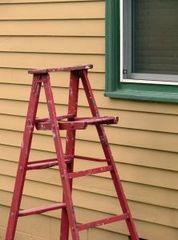How to Paint Houses
Updated: 2022-01-12
By Paul Bianchina
So you've finally decided that it's time to spruce up the outside of the house with a fresh coat of paint. Well before you have the paint mixed and start dragging out the ladders and brushes, you need to take some time getting the house ready. The more time and effort you put into proper preparation, the easier your painting tasks will be and, even more importantly, the longer the paint job will last.
So you've finally decided that it's time to spruce up the outside of the house with a fresh coat of paint. Well before you have the paint mixed and start dragging out the ladders and brushes, you need to take some time getting the house ready. The more time and effort you put into proper preparation, the easier your painting tasks will be and, even more importantly, the longer the paint job will last.

INITIAL PRECAUTIONS
All of the steps involved in preparing a house for painting also require some precautions that are serious enough that they can't be ignored. Eye protection is essential to guard against dust and flying paint chips, and you need to wear a dust mask or respirator for protection against dust inhalation while sanding.
If you own an older house, you need to very aware of the potential dangers posed by lead paint. Prior to the government's ban on lead paint in 1978, many homes were painted with materials containing lead, and sanding or scraping lead paint can pose some serious health risks. If you have a home that was built prior to the early 1980s and you suspect that your house has lead paint, be sure to have it tested prior to undertaking any paint repairs. You can get more information from the Environmental Protection Agency at www.epa.gov/lead/ or by calling the National Lead Information Center (NLIC) at 1-800-424-LEAD (5323).
FIX IT AND CLEAN IT
First, you need to complete any necessary repairs. If the weather has rotted or splintered siding or trim boards, for example, they need to be replaced or re-secured before proceeding. This includes repairs to windows and doors, weatherstripping, roofing and any other damaged areas. Don't think that fresh paint over a cracked board is going to be the answer -- you're just asking for trouble down the road.
The next step is to clean the house, which removes surface dirt that will prevent the new paint from sticking well, and will help expose areas of peeling or damaged paint that require additional attention. You can use a garden hose or a pressure washer, but stick to a wide spray nozzle that doesn't concentrate a strong stream of water onto the siding. Most pressure washers have soap injectors, which allow a small amount of soap to be mixed with the water stream -- that may help if the house is particularly dirty. Use a soft- or medium-bristle nylon brush on a pole for best dirt removal.
Now you need to remove any loose or peeling paint, working back until you are certain you're into undamaged paint that is well adhered to the underlying surface. There's really no easy way to accomplish this -- it just takes time and elbow grease. One tried and true method is to use a paint scraper. Hold the scraper at a low angle, relatively parallel with the board you're scraping, and work with short, firm strokes to scrape the paint off. Work with the grain of the wood to avoid raising grain fibers, and be careful not to dig into the wood's surface.
Another option is to use a sander. For small areas, a pad or belt sander will work fine. For larger areas, you might consider renting a disk sander that is specially designed for paint removal. Either way, sand only enough to remove the loose paint -- well-adhered paint can remain, and you want to be sure you don't sand down into the siding itself.
Avoid the temptation to use a pressure washer to remove the loose paint. Getting a strong enough water stream to be effective at removing paint requires the use of a small nozzle that really concentrates the water pressure, which in turn can damage the siding and drive moisture deep into it.
If the siding, trim or other surfaces you're working on have been painted several times in the past, when you have scraped down to bare wood you may notice that the surrounding areas of existing paint are considerably higher than the surface of the wood. This will show through your final paint job, so take some sandpaper and feather the sharp edges of the old paint so that it blends more smoothly down to the bare wood areas.
Make sure all the surfaces are completely dry, both from washing and from the effects of winter weather. Painting over damp wood will simply cause the paint to fail prematurely.
Now, apply a good-quality primer over any bare spots. Use a primer that is compatible with the final paint you'll be using, and that is compatible with the surface material (wood, brick, concrete, etc.). Your paint store can assist you with selecting the best primer for your particular application. For areas that are very dry or badly weathered, apply two coats of primer to equalize paint absorption with the rest of the siding.
Finally, re-caulk any areas that require it, closing up all the gaps in the siding and trim before painting. If you have done a lot of sanding and scraping, a light final washing may be required to remove residual dust. Once again, be sure the house is completely dry before painting.
Comments (0)
